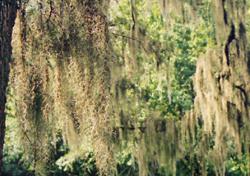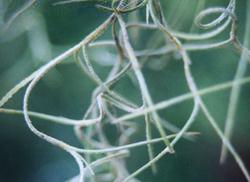Difference between revisions of "Tillandsia usneoides"
| (3 intermediate revisions by 2 users not shown) | |||
| Line 1: | Line 1: | ||
| − | + | {{SPlantbox | |
| − | | | + | |familia=Bromeliaceae |
| − | | | + | |genus=Tillandsia |
| − | | | + | |species=usneoides |
| − | | | + | |taxo_author=L. |
| − | | | + | |common_name=Old man's beard, Spanish moss |
| − | | | + | |name_ref=Flora - A Gardener's Encyclopedia |
| − | | | + | |habit=bromeliad |
| − | | | + | |habit_ref=Flora - A Gardener's Encyclopedia |
| − | | exposure = | + | |Max ht box=24 |
| − | | | + | |Max ht metric=in |
| − | | features = | + | |height_ref=Flora - A Gardener's Encyclopedia |
| − | | | + | |Max wd box=4 |
| − | | | + | |Max wd metric=in |
| − | | | + | |width_ref=Flora - A Gardener's Encyclopedia |
| − | | | + | |exposure=shade |
| − | | | + | |sun_ref=Flora - A Gardener's Encyclopedia |
| − | | image = Spanish moss at the Mcbryde Garden in hawaii.jpg | + | |features=flowers |
| − | | image_width = | + | |flower_season=early summer, mid summer, late summer |
| − | + | |flower_ref=Flora - A Gardener's Encyclopedia | |
| − | + | |flowers=blue, purple | |
| − | + | |Temp Metric=°F | |
| − | + | |min_zone=11 | |
| − | + | |usda_ref=Flora - A Gardener's Encyclopedia | |
| − | + | |max_zone=12 | |
| − | + | |image=Spanish moss at the Mcbryde Garden in hawaii.jpg | |
| − | + | |image_width=200 | |
| − | |||
| − | |||
}} | }} | ||
| + | '''Spanish moss''' (''Tillandsia usneoides'') is a [[flowering plant]] that grows upon larger [[tree]]s, commonly the Southern Live Oak (''[[Quercus virginiana]]'') or Bald Cypress (''[[Taxodium distichum]]'') in the [[southeastern United States]]. | ||
| + | |||
| + | Spanish moss closely resembles its [[Specific name|namesake]] (''[[Usnea]]'', or beard lichen), but in fact it is not biologically related to either [[moss]]es or [[lichen]]s. Instead, it is an [[angiosperm]] in the family [[Bromeliaceae]] (the bromeliads) that grows hanging from tree branches in full sun or partial shade. Formerly this plant has been placed in the genera ''Anoplophytum'', ''Caraguata'', and ''Renealmia''.<ref>[http://www.ars-grin.gov/cgi-bin/npgs/html/genus.pl?12153 Genus: Tillandsia L.], GRIN Taxonomy for Plants, Agricultural Research Service, United States Department of Agriculture.</ref> It ranges from the [[southeastern United States]] (southern [[Virginia]] and eastern [[Maryland]]) to [[Argentina]], growing wherever the [[climate]] is warm enough and has a relatively high average [[humidity]]. | ||
| + | |||
| + | The plant consists of a slender stem bearing alternate thin, curved or curly, heavily scaled [[leaf|leaves]] {{convert|2|–|6|cm|in|abbr=on}} long and {{convert|1|mm|in|abbr=on}} broad, that grow vegetatively in chain-like fashion (pendant) to form hanging structures up to {{convert|6|m|in|abbr=on}}<ref>http://www.floridata.com/ref/T/till_usn.cfm</ref> in length. The plant has no [[aerial root]]s <ref>http://www.floridata.com/ref/T/till_usn.cfm</ref>and its [[flower]]s are tiny and inconspicuous. It propagates both by [[seed]] and [[Vegetative reproduction|vegetatively]] by fragments that blow on the wind and stick to tree limbs, or are carried by [[bird]]s as nesting material. | ||
| + | |||
| + | Spanish moss is an [[epiphyte]] (a plant that lives upon other plants; from [[Greek language|Greek]] "epi"=upon "phyte"=plant), which absorbs [[nutrient]]s (especially [[calcium]]) and [[water]] from the air and [[rain]]fall. Spanish moss is colloquially known as "air plant". | ||
| + | |||
{{Inc| | {{Inc| | ||
Tillandsia usneoides, Linn. Spanish, Florida, or Long Moss. Whole plant hoary-gray, hanging from trees, the sts. very slender and often several feet long: lvs. scattered, narrow-linear, 1-3 in. long: fls. solitary in the lf.-axils, small and not showy, the petals yellow and reflexed at the end. Trop. Amer. and in the U. S. from Texas to Fla. and E. Va.; extends southward to S. Brazil. —This is one of the most characteristic plants of our southern regions. In moist regions it gives a most weird aspect to the forests. It is used as a packing material, and also, when specially prepared, for upholstery. It is rarely cult., although it is not uncommon in greenhouses, being hung on branches and beams; but it must be renewed frequently. The plant is named for its resemblance to the lichen Usnea. | Tillandsia usneoides, Linn. Spanish, Florida, or Long Moss. Whole plant hoary-gray, hanging from trees, the sts. very slender and often several feet long: lvs. scattered, narrow-linear, 1-3 in. long: fls. solitary in the lf.-axils, small and not showy, the petals yellow and reflexed at the end. Trop. Amer. and in the U. S. from Texas to Fla. and E. Va.; extends southward to S. Brazil. —This is one of the most characteristic plants of our southern regions. In moist regions it gives a most weird aspect to the forests. It is used as a packing material, and also, when specially prepared, for upholstery. It is rarely cult., although it is not uncommon in greenhouses, being hung on branches and beams; but it must be renewed frequently. The plant is named for its resemblance to the lichen Usnea. | ||
| Line 47: | Line 53: | ||
==Gallery== | ==Gallery== | ||
| − | + | <gallery perrow=5> | |
| − | + | Image:Spanish moss.jpg|Spanish moss growing on an oak tree. | |
| − | + | Image:DirkvdM orosi mossy tree.jpg|Spanish moss in [[Costa Rica]]. | |
| − | Image: | + | Image:Sp_moss_CU_th.jpg|Close-up of Spanish moss. |
| − | Image: | + | Image:Spanish-moss-tree.jpg|[[Quercus virginiana|Southern Live Oak]] with Spanish moss hanging from it. |
| − | Image: | + | Image:Mousse espagnole en Louisiane.JPG|Spanish moss in [[Louisiana]]. |
| + | Image:Peles Hair.jpg|{{okina}}Umi{{okina}}umi-o-Dole with a [[taro]] leaf background. | ||
| + | Image:Spanish moss sg.jpg|Spanish moss on a tree at a park in [[Singapore]]. | ||
| + | Image:Spanish_moss_sc.jpg|Spanish moss growing on a tree on [[Hilton Head Island, South Carolina]] | ||
Image:Sp moss CU th.jpg|Closeup | Image:Sp moss CU th.jpg|Closeup | ||
</gallery> | </gallery> | ||
| Line 66: | Line 75: | ||
{{stub}} | {{stub}} | ||
| − | + | __NOTOC__ | |
| − | |||
| − | |||
Latest revision as of 23:36, 27 April 2010
| Habit | bromeliad
| |
|---|---|---|
| Height: | ⇕ | 24 in"in" can not be assigned to a declared number type with value 24. |
| Width: | ⇔ | 4 in"in" can not be assigned to a declared number type with value 4. |
| Bloom: | ❀ | early summer, mid summer, late summer |
| Exposure: | ☼ | shade |
|---|---|---|
| Features: | ✓ | flowers |
| USDA Zones: | 11 to 12 | |
| Flower features: | ❀ | blue, purple |
|
L. > |
Spanish moss (Tillandsia usneoides) is a flowering plant that grows upon larger trees, commonly the Southern Live Oak (Quercus virginiana) or Bald Cypress (Taxodium distichum) in the southeastern United States.
Spanish moss closely resembles its namesake (Usnea, or beard lichen), but in fact it is not biologically related to either mosses or lichens. Instead, it is an angiosperm in the family Bromeliaceae (the bromeliads) that grows hanging from tree branches in full sun or partial shade. Formerly this plant has been placed in the genera Anoplophytum, Caraguata, and Renealmia.[1] It ranges from the southeastern United States (southern Virginia and eastern Maryland) to Argentina, growing wherever the climate is warm enough and has a relatively high average humidity.
The plant consists of a slender stem bearing alternate thin, curved or curly, heavily scaled leaves 2 – 6 cm long and 1 mm in broad, that grow vegetatively in chain-like fashion (pendant) to form hanging structures up to 6 m in [2] in length. The plant has no aerial roots [3]and its flowers are tiny and inconspicuous. It propagates both by seed and vegetatively by fragments that blow on the wind and stick to tree limbs, or are carried by birds as nesting material.
Spanish moss is an epiphyte (a plant that lives upon other plants; from Greek "epi"=upon "phyte"=plant), which absorbs nutrients (especially calcium) and water from the air and rainfall. Spanish moss is colloquially known as "air plant".
Read about Tillandsia usneoides in the Standard Cyclopedia of Horticulture
|
|---|
|
Tillandsia usneoides, Linn. Spanish, Florida, or Long Moss. Whole plant hoary-gray, hanging from trees, the sts. very slender and often several feet long: lvs. scattered, narrow-linear, 1-3 in. long: fls. solitary in the lf.-axils, small and not showy, the petals yellow and reflexed at the end. Trop. Amer. and in the U. S. from Texas to Fla. and E. Va.; extends southward to S. Brazil. —This is one of the most characteristic plants of our southern regions. In moist regions it gives a most weird aspect to the forests. It is used as a packing material, and also, when specially prepared, for upholstery. It is rarely cult., although it is not uncommon in greenhouses, being hung on branches and beams; but it must be renewed frequently. The plant is named for its resemblance to the lichen Usnea. CH
|
Cultivation
- Do you have cultivation info on this plant? Edit this section!
Propagation
- Do you have propagation info on this plant? Edit this section!
Pests and diseases
- Do you have pest and disease info on this plant? Edit this section!
Species
Gallery
Spanish moss in Costa Rica.
Southern Live Oak with Spanish moss hanging from it.
Spanish moss in Louisiana.
Template:OkinaUmiTemplate:Okinaumi-o-Dole with a taro leaf background.
Spanish moss on a tree at a park in Singapore.
Spanish moss growing on a tree on Hilton Head Island, South Carolina
References
- Standard Cyclopedia of Horticulture, by L. H. Bailey, MacMillan Co., 1963
External links
- w:Tillandsia usneoides. Some of the material on this page may be from Wikipedia, under the Creative Commons license.
- Tillandsia usneoides QR Code (Size 50, 100, 200, 500)
- ↑ Genus: Tillandsia L., GRIN Taxonomy for Plants, Agricultural Research Service, United States Department of Agriculture.
- ↑ http://www.floridata.com/ref/T/till_usn.cfm
- ↑ http://www.floridata.com/ref/T/till_usn.cfm








